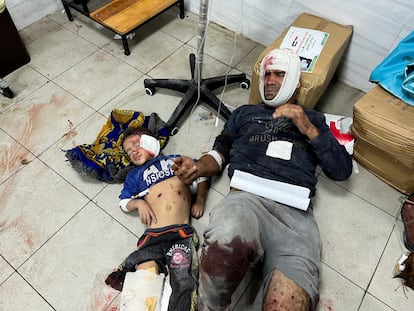Israel intensifies siege on Gaza health centers and surrounds Indonesian hospital with tanks
The Israeli army also accuses this medical complex of harboring Hamas facilities and is escalating its efforts to prove that the civilian targets it attacks are being used for military purposes


The Israeli army continues to target hospitals in Gaza, which are considered untouchable by international humanitarian law due to their civilian and sanitary nature. On Monday, Israeli tanks surrounded the Indonesian hospital in the north of the Gaza Strip, where snipers posted nearby were firing at anyone who ventured to leave the medical complex, which currently houses 700 people, according to Al Jazeera. At least 12 people were killed in heavy artillery shelling on the medical complex, according to authorities in the Hamas-ruled Palestinian enclave. Another hospital in northern Gaza, Al Awda, is also surrounded by Israeli forces, according to the Palestinian news agency Wafa. As the hospitals are encircled by invading troops, Israel is stepping up its efforts to prove that these medical centers harbor Hamas infrastructure, which — they argue — could exempt Israeli forces from committing the war crime of attacking civilian targets.
The Indonesian hospital is located in Beit Lahia, on the outskirts of the largest Gazan refugee camp, Jabaliya — one of the areas where the Israeli army has announced it will extend its military offensive. The siege of the medical complex was unannounced, several of its workers told Al Jazeera. They described damage to its main operating room and a complete lack of power resulting from an Israeli attack on the hospital’s generator. Of the 35 hospitals in the Gaza Strip before the war, only four are still functioning, according to the Gaza Ministry of Health. The only one still operating in the northern region — where most of the relentless Israeli bombardment is concentrated —, according to that source, is Al Ahli, whose emergency staff reported on Saturday that the Israeli military had surrounded it for three days. The U.N., for its part, estimates that nine medical centers are still functioning — barely.
With tanks at the gates of the Indonesian hospital, Ashraf al-Qidra, spokesman for the Gaza Ministry of Health, told Agence France Presse that he feared “the same thing that happened in Al Shifa” would be repeated in the Indonesian complex. He was referring to the siege that began on Wednesday of the largest hospital in the Palestinian territory, from which thousands of people were evicted on Saturday by the Israeli army. A World Health Organization (WHO) mission, authorized to enter the hospital for an hour that same day, described it as a “death zone” and noted the trail left by explosions and gunfire.
The Israeli Defense Forces (IDF) justified its attack on Al Shifa with the argument that its subsoil housed a Hamas command center, an accusation analogous to the one it is now directing against the Indonesian hospital, which it claims is also used by the fundamentalist movement for military purposes. The Israeli military establishment claims — without proof — that beneath the hospital’s operating rooms is a network of Hamas underground tunnels. The organization that runs the hospital, the Emergency Medical Rescue Committee, denies this claim, as does Indonesia, which finances the medical center. Indonesian Foreign Minister Retno Marsudi described the siege of the hospital as a “clear violation of international humanitarian law.”
No conclusive evidence
The day after clearing Al Shifa, the Israeli military released a video showing what they described as “a significant 55-meter-long terrorist tunnel, 10 meters underneath the Shifa hospital complex.” Nothing in the video’s unclear footage can be linked to Hamas’ underground tunnel network. Also inconclusive is another footage the IDF shared, in which it claims that two of the 240 people Hamas kidnapped on October 7 can be seen being brought into the hospital compound, one of them wounded on a stretcher.
OPERATIONAL UPDATE: IDF and ISA forces revealed a significant 55-meter-long terrorist tunnel, 10 meters underneath the Shifa Hospital complex during an intelligence-based operation.
— Israel Defense Forces (@IDF) November 19, 2023
The tunnel entrance contains various defense mechanisms, such as a blast-proof door and a firing… pic.twitter.com/tU4J6BD4ZG
These videos, some images of weapons laid out on a table, and a simple computer with a stack of CDs next to it are supposed to prove that Al Shifa was used for military purposes. Should the Israeli army get its way, the hospital could lose the status of a civilian target with enhanced protection granted to health facilities under international humanitarian law. This would exonerate Israel from committing a number of war crimes as established in the Geneva Conventions of 1949 and their additional protocols of 1977.
So far, Israel has not succeeded in its objective. The IDF has also failed to justify its “surgical” approach to its war in Gaza, including attacks on hospitals and schools where hundreds of thousands of displaced people are sheltering. In the past six weeks, at least 13,000 people, including 5,500 children, have been killed, according to the Hamas government in Gaza.
On the contrary, the number of images, videos, and testimonies documenting attacks on innocent civilians — including babies and young children — is overwhelming. Photographs such as those of the seriously ill 31 premature infants evacuated from Al Shifa hospital to Rafah (28 of them are already in Egypt) after spending several days outside incubators deal a heavy blow to Israel’s official version. On Monday, U.N. Secretary-General António Guterres said the killing of children in Gaza since the war between Israel and Hamas began was “unprecedented” in any conflict since he took office in 2017. Guterres was responding to a question on whether the weekend attacks on two U.N. agency for Palestinian refugees (UNRWA) schools, in which dozens of displaced people were killed, constitute war crimes.
Photographs of those infants huddled together in a bed and Guterres’ statements bring into disrepute Israel’s position in front of the international community. Even with regard to its main supporter, the United States, whose endorsement recently has taken on barely perceptible nuances and only in relation to the entry of humanitarian aid and Washington’s refusal to endorse a permanent Israeli occupation of Gaza.
Despite this homeopathic censure, U.S. support for Israel remains ironclad, even on the only domestic issue that puts Benjamin Netanyahu’s government in immediate trouble: the fate of the 240 hostages held by Hamas. This Monday, President Joe Biden expressed his hope that Israel will finalize the Qatar-mediated pact with Hamas to free them. “I believe that an agreement on the release of hostages in Gaza will be reached soon,” the U.S. president said. Such a compromise would ease the internal pressure on the Netanyahu government, which has been questioned by the families of these captives, who reproach it for its indifference towards the hostages still being held. The Israeli government is also divided between those in favor of expanding the offensive so that Hamas will lower its demands and those who fear that the opportunity will be wasted and that other hostages will be killed in the bombing, according to the Haaretz newspaper. The agreement would consist of releasing between 50 and 70 mothers and children, in exchange for three to five days of humanitarian pause, and the release of 150 Palestinian minors and women.
A Jordanian hospital
On Monday, for the first time since the start of the fighting, a field hospital was allowed to enter the Strip through Rafah, according to Mohammed Zaqout, director general of hospitals in Gaza, as reported by Reuters. Zaqout said the field hospital, sent by Jordan, will be set up in the southern town of Khan Younis. According to the Gaza Health Ministry, at least 30,000 people have been wounded in the Strip. Many of them seriously.
Meanwhile, in the early hours of Monday morning, 14 Palestinians were killed in an Israeli strike on a residential building in Rafah, in southern Gaza, where the Israeli army told displaced people to go to be safe from bombardments. Six weeks of war in Gaza have already killed more people — at least 13,000 — than the 12,000 or so who died in the four-year siege of Sarajevo between 1992 and 1996.
Doaa Ulyan, 33, was with her two children, aged eight and 10, respectively, when the windows of the shelter where she is trying to find safety were blown out this Monday morning in the Israeli attack, she explains via WhatsApp from Rafah. “I couldn’t go outside to look. My children were crying, terrified by the roar. Besides, I can’t bear to see the scenes we see here anymore.”
Ulyan just wants, she explains, “to escape from Gaza.” She has a legal visa for Spain, where her entire family lives, but her children and husband do not, and the Spanish Consulate in Jerusalem has told her it cannot help her. “I just want them to help me cross the border with my children. Sometimes it takes us two days to find some bread for the children. No one knows what it is like to be terrified and to have your children cry from hunger and not have food to give them. This is no life,” she says in tears, adding that she no longer has a home to go back to. An Israeli bomb wiped out her house in Gaza City.
Sign up for our weekly newsletter to get more English-language news coverage from EL PAÍS USA Edition
Tu suscripción se está usando en otro dispositivo
¿Quieres añadir otro usuario a tu suscripción?
Si continúas leyendo en este dispositivo, no se podrá leer en el otro.
FlechaTu suscripción se está usando en otro dispositivo y solo puedes acceder a EL PAÍS desde un dispositivo a la vez.
Si quieres compartir tu cuenta, cambia tu suscripción a la modalidad Premium, así podrás añadir otro usuario. Cada uno accederá con su propia cuenta de email, lo que os permitirá personalizar vuestra experiencia en EL PAÍS.
¿Tienes una suscripción de empresa? Accede aquí para contratar más cuentas.
En el caso de no saber quién está usando tu cuenta, te recomendamos cambiar tu contraseña aquí.
Si decides continuar compartiendo tu cuenta, este mensaje se mostrará en tu dispositivo y en el de la otra persona que está usando tu cuenta de forma indefinida, afectando a tu experiencia de lectura. Puedes consultar aquí los términos y condiciones de la suscripción digital.
More information
Archived In
Últimas noticias
Maduro counterattacks Trump with rhetoric and announces downing of nine drug trafficking aircraft
‘Ecce Homo’: The miraculous disaster that made a small Spanish town famous
Return to sex testing at the Olympics: IOC edges closer to banning transgender women
Trump escalates conflict with Venezuela with the start of covert operations
Most viewed
- Sinaloa Cartel war is taking its toll on Los Chapitos
- Oona Chaplin: ‘I told James Cameron that I was living in a treehouse and starting a permaculture project with a friend’
- Reinhard Genzel, Nobel laureate in physics: ‘One-minute videos will never give you the truth’
- Why the price of coffee has skyrocketed: from Brazilian plantations to specialty coffee houses
- Silver prices are going crazy: This is what’s fueling the rally









































